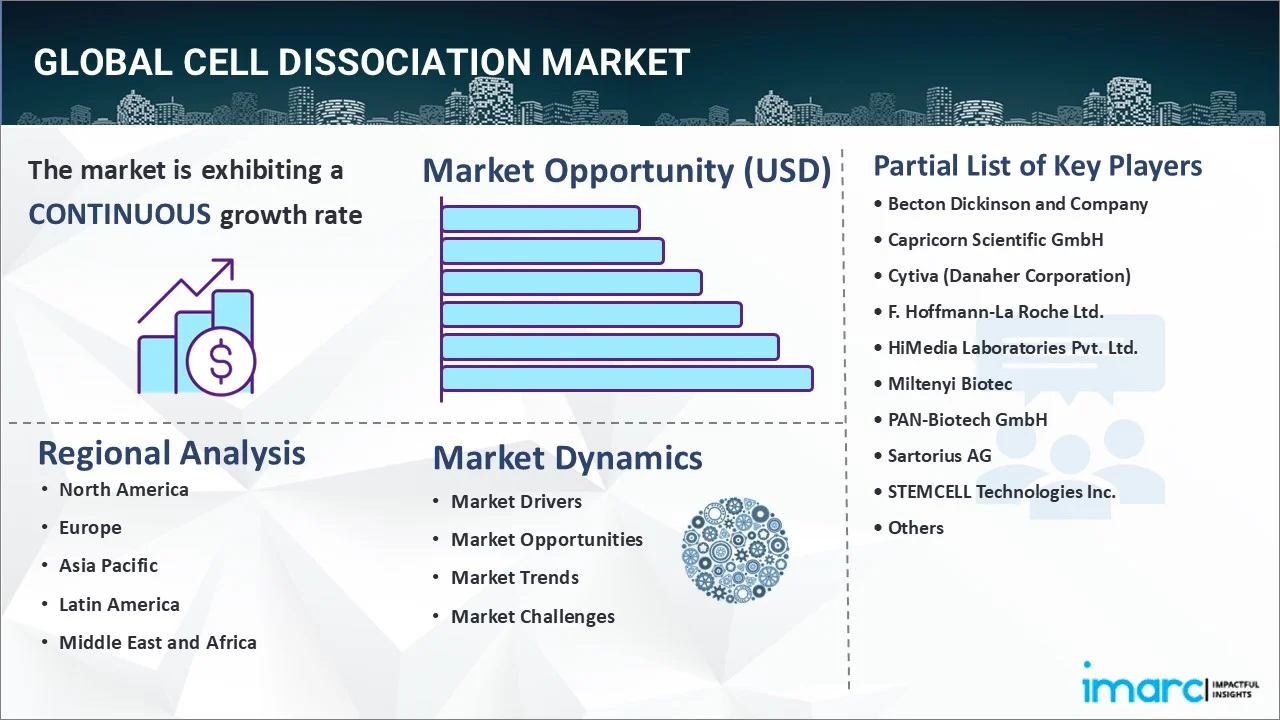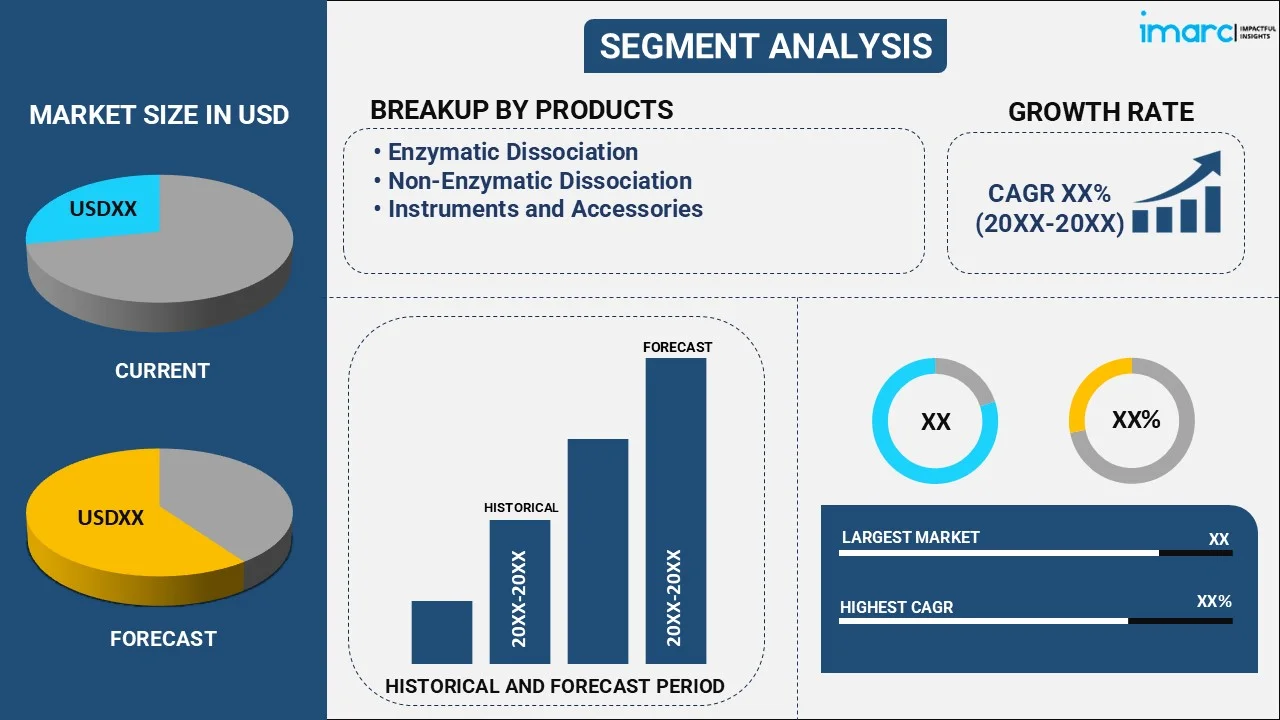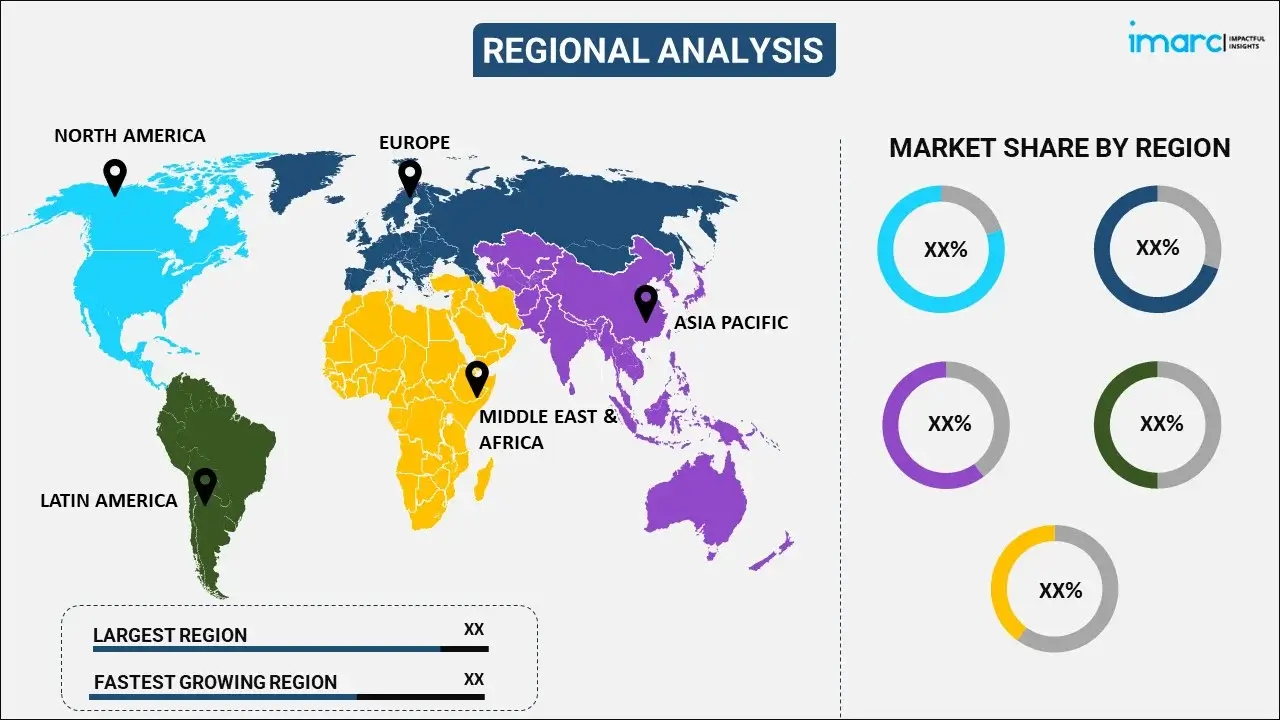
Cell Dissociation Market Report by Product (Enzymatic Dissociation, Non-Enzymatic Dissociation, Instruments and Accessories), Type (Tissue Dissociation, Cell Detachment), End Use (Pharmaceutical and Biotechnology Companies, Research and Academic Institutes), and Region 2025-2033
Cell Dissociation Market Size:
The global cell dissociation market size reached USD 404.8 Million in 2024. Looking forward, IMARC Group expects the market to reach USD 1,186.4 Million by 2033, exhibiting a growth rate (CAGR) of 12.06% during 2025-2033. The market is expanding rapidly due to the growing investments by governing agencies in the biopharmaceutical industry and increasing development of vaccines. Moreover, the rising number of clinical trials of various drugs and therapies represent another key factor driving the market demand significantly.
|
Report Attribute
|
Key Statistics
|
|---|---|
|
Base Year
|
2024 |
|
Forecast Years
|
2025-2033
|
|
Historical Years
|
2019-2024
|
| Market Size in 2024 | USD 404.8 Million |
| Market Forecast in 2033 | USD 1,186.4 Million |
| Market Growth Rate (2025-2033) | 12.06% |
Cell dissociation refers to the process of breaking down a cell culture to isolate a small group of cells or single individual cells. It relies on a wide variety of dissociation reagents, such as trypsin and collagenase, which are enzymes and digest pieces of tissue to release the target cells. It is also promoted by utilizing chemicals, such as ethylenediamine tetraacetic (EDTA) solutions, ethylene glycol-bis(β-aminoethyl ether)-N,N,N′,N′-tetraacetic acid (EGTA), and egtazic acid, which does not alter the surface of the cells and provides safe and gentle application. Cell dissociation is often performed by mechanical methods and involve breaking down of tissues with physical forces, such as cutting, crushing, and scrapping, to isolate individual cells. It is used with a specialized device wherein cell cultures are transferred into a single-cell suspension medium, followed by detaching cells from the host tissue and further isolating them from various residual substances or debris. Furthermore, as cell dissociation enables researchers to target and isolate a wide variety of cells, its demand is increasing around the world.

Cell Dissociation Market Trends:
Growing Demand for Cell-Based Research and Therapies
One of the critical trends shaping the global market include heightening emphasis on cell-based research and regenerative medicine. As advancements in stem cell therapies and tissue engineering propel, there is an intensifying demand for effective cell dissociation solutions to isolate and culture cells. Moreover, this demand is particularly dominant in personalized medicine and drug discovery, where the dissociation of primary cells is crucial. Moreover, increasing government and private sector funding for cell-based research, including stem cell and tumor cell studies, is driving the demand for efficient dissociation products in both clinical and laboratory settings, thereby fueling cell dissociation market growth. For instance, in May 2023, StemCures, a major U.S.-based medical clinic, announced a substantial investment of USD 54 million for the development of India's largest stem cell manufacturing laboratory, which is expected to bolster stem cell research in the country.
Technological Innovations in Enzymatic and Non-Enzymatic Solutions
Ongoing technological advancements are transforming the cell dissociation market, especially through the development of improved enzymatic and non-enzymatic dissociation solutions. Such advanced products provide more accurate, gentle, and effective cell separation methods, reducing damage to cells and improving viability for downstream applications. Furthermore, non-enzymatic solutions, such as mechanical or chemical techniques, are rapidly being preferred in research to avoid the negative impact of enzymes on sensitive cell types. For instance, in February 2023, researchers at the University of Alabama developed an innovative method to fix cells prior to their dissociation, eliminating the need for enzymatic treatment by using vivoPHIX, a deep eutectic solvent (DES). This solvent quickly fixes the cells, facilitating biomolecule stabilization and enabling single-cell dissociation. In addition, continuous advancements in this area facilitates better dependability and consistency, bolstering the expansion of cell dissociation market share as such techniques are adopted across numerous life sciences segments.
Increasing Applications in Cancer Research
The utilization of cell dissociation products is expanding rapidly in cancer research, as scientists require efficient methods to isolate tumor cells for study. The escalating prevalence of cancer globally further boosts the need for cell dissociation techniques, as more patients undergo research-based treatments and diagnostics. According to the WHO, by the year 2050, approximately 35 million new cancer cases are anticipated, with an estimated 142% increase in low human development index (HDI) countries and a 99% increase in medium HDI countries. Moreover, advances in immuno-oncology and the development of personalized cancer therapies are driving the need for better cell separation techniques, including those that can dissociate complex tumor microenvironments. Besides this, the increasing use of 3D cell culture and organoids in cancer research creates additional demand for reliable dissociation products. In addition, the growing focus on precision oncology and targeted therapies is expected to further accelerate the adoption of cell dissociation solutions in cancer-related studies.
Cell Dissociation Market Segmentation:
IMARC Group provides an analysis of the key trends in each segment of the market, along with forecasts at the global, regional, and country levels for 2025-2033 Our report has categorized the market based on product, type, and end use.
Breakup by Product:

- Enzymatic Dissociation
- Trypsin
- Collagenase
- Elastase
- Papain
- Hyaluronidase
- DNase
- Others
- Non-Enzymatic Dissociation
- Instruments and Accessories
Enzymatic dissociation accounts for the majority of the market share
The report has provided a detailed breakup and analysis of the market based on the product. This includes enzymatic dissociation (trypsin, collagenase, elastase, papain, hyaluronidase, DNase, and others), non-enzymatic dissociation, and instruments and accessories. According to the report, enzymatic dissociation represented the largest segment.
Breakup by Type:
- Tissue Dissociation
- Cell Detachment
Tissue dissociation holds the largest share of the industry
A detailed breakup and analysis of the market based on the type have also been provided in the report. This includes tissue dissociation and cell detachment. According to the report, tissue dissociation accounted for the largest market share.
Breakup by End Use:
- Pharmaceutical and Biotechnology Companies
- Research and Academic Institutes
Pharmaceutical and biotechnology companies represent the leading market segment
The report has provided a detailed breakup and analysis of the market based on the end use. This includes pharmaceutical and biotechnology companies and research and academic institutes. According to the report, pharmaceutical and biotechnology companies represented the largest segment.
Breakup by Region:

- North America
- United States
- Canada
- Europe
- Germany
- France
- United Kingdom
- Italy
- Spain
- Others
- Asia Pacific
- China
- Japan
- India
- South Korea
- Australia
- Indonesia
- Others
- Latin America
- Brazil
- Mexico
- Others
- Middle East and Africa
North America leads the market, accounting for the largest cell dissociation market share
The report has also provided a comprehensive analysis of all the major regional markets, which include North America (the United States and Canada); Europe (Germany, France, the United Kingdom, Italy, Spain, and others); Asia Pacific (China, Japan, India, South Korea, Australia, Indonesia, and others); Latin America (Brazil, Mexico, and others); and the Middle East and Africa. According to the report, North America represents the largest regional market for cell dissociation. Some of the factors driving the North America cell dissociation market included the growing demand for personalized medicine, rising research and development (R&D) activities on developing novel drugs, increasing expenditure on healthcare sector, etc.
Competitive Landscape:
The report has also provided a comprehensive analysis of the competitive landscape in the global cell dissociation market. Competitive analysis such as market structure, market share by key players, player positioning, top winning strategies, competitive dashboard, and company evaluation quadrant has been covered in the report. Also, detailed profiles of all major companies have been provided. Some of the companies covered include:
- Becton Dickinson and Company
- Capricorn Scientific GmbH
- Cytiva (Danaher Corporation)
- F. Hoffmann-La Roche Ltd.
- HiMedia Laboratories Pvt. Ltd.
- Miltenyi Biotec
- PAN-Biotech GmbH
- Sartorius AG
- STEMCELL Technologies Inc.
- Thermo Fisher Scientific Inc.
- Vitacyte LLC
Kindly note that this only represents a partial list of companies, and the complete list has been provided in the report.
Cell Dissociation Market News:
- In September 2024, Singleron launched its sCelLiVE® Tissue Dissociation Kit (Skin) for both mouse and human skin tissue. This innovative product substantially lowers processing time while sustaining 90% cell viability and characteristics, facilitating excellent-quality downstream analysis, including single cell sequencing.
- In March 2023, Agilent Technologies Inc. announced the strategic acquisition of e-MSion, the developer of the innovative ExD cell technology for electron capture dissociation. This compact device enhances mass spectrometry capabilities, enabling biotherapeutic development. Its accessibility is expected to significantly impact the cell dissociation market by improving analysis efficiency for researchers.
Cell Dissociation Market Report Scope:
| Report Features | Details |
|---|---|
| Base Year of the Analysis | 2024 |
| Historical Period | 2019-2024 |
| Forecast Period | 2025-2033 |
| Units | Million USD |
| Scope of the Report | Exploration of Historical and Forecast Trends, Industry Catalysts and Challenges, Segment-Wise Historical and Predictive Market Assessment:
|
| Products Covered |
|
| Types Covered | Tissue Dissociation, Cell Detachment |
| End Uses Covered | Pharmaceutical and Biotechnology Companies, Research and Academic Institutes |
| Regions Covered | Asia Pacific, Europe, North America, Latin America, Middle East and Africa |
| Countries Covered | United States, Canada, Germany, France, United Kingdom, Italy, Spain, China, Japan, India, South Korea, Australia, Indonesia, Brazil, Mexico |
| Companies Covered | Becton Dickinson and Company, Capricorn Scientific GmbH, Cytiva (Danaher Corporation), F. Hoffmann-La Roche Ltd., HiMedia Laboratories Pvt. Ltd., Miltenyi Biotec, PAN-Biotech GmbH, Sartorius AG, STEMCELL Technologies Inc., Thermo Fisher Scientific Inc., Vitacyte LLC, etc. |
| Customization Scope | 10% Free Customization |
| Post-Sale Analyst Support | 10-12 Weeks |
| Delivery Format | PDF and Excel through Email (We can also provide the editable version of the report in PPT/Word format on special request) |
Key Questions Answered in This Report:
- How has the global cell dissociation market performed so far, and how will it perform in the coming years?
- What are the drivers, restraints, and opportunities in the global cell dissociation market?
- What is the impact of each driver, restraint, and opportunity on the global cell dissociation market?
- What are the key regional markets?
- Which countries represent the most attractive cell dissociation market?
- What is the breakup of the market based on the product?
- Which is the most attractive product in the cell dissociation market?
- What is the breakup of the market based on the type?
- Which is the most attractive type in the cell dissociation market?
- What is the breakup of the market based on the end use?
- Which is the most attractive end use in the cell dissociation market?
- What is the competitive structure of the global cell dissociation market?
- Who are the key players/companies in the global cell dissociation market?
Key Benefits for Stakeholders:
- IMARC’s report offers a comprehensive quantitative analysis of various market segments, historical and current market trends, market forecasts, and dynamics of the cell dissociation market from 2019-2033.
- The research study provides the latest information on the market drivers, challenges, and opportunities in the global cell dissociation market.
- The study maps the leading, as well as the fastest-growing, regional markets. It further enables stakeholders to identify the key country-level markets within each region.
- Porter's five forces analysis assist stakeholders in assessing the impact of new entrants, competitive rivalry, supplier power, buyer power, and the threat of substitution. It helps stakeholders to analyze the level of competition within the cell dissociation industry and its attractiveness.
- Competitive landscape allows stakeholders to understand their competitive environment and provides an insight into the current positions of key players in the market.
Need more help?
- Speak to our experienced analysts for insights on the current market scenarios.
- Include additional segments and countries to customize the report as per your requirement.
- Gain an unparalleled competitive advantage in your domain by understanding how to utilize the report and positively impacting your operations and revenue.
- For further assistance, please connect with our analysts.
 Inquire Before Buying
Inquire Before Buying
 Speak to an Analyst
Speak to an Analyst
 Request Brochure
Request Brochure
 Request Customization
Request Customization




.webp)




.webp)












